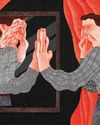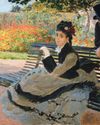
In his letters, Heaney weighed his competing obligations as a poet.
When people asked the poet Seamus Heaney what it was like to be living in Belfast, Northern Ireland, at the start of the Troubles, he tended to downplay the violence: “Things aren’t too bad in our part of the town.” But things were, in fact, quite bad. A kind of martial law obtained. British soldiers, brought in to suppress a Catholic civil-rights movement, ran checkpoints, frisked young men, and stopped drivers for the smallest infractions. Aggressive slogans adorned buildings: “Keep Ulster Protestant,” “Keep Blacks and Fenians Out of Ulster.” Worst of all were the bombs, which exploded everywhere and seemingly at random: in department stores, in transit centers, in pubs, in banks. Some were planted by the Provisional Irish Republican Army, others by Protestant vigilantes.
These developments alarmed Heaney the citizen—a lifelong Northerner, an Irish Catholic—and they challenged Heaney the poet. Should he, in his art, respond to the conflict—and, if so, how? To write his first two, well-received collections, he had started in what he called “the ground of memory and sensation,” often with scenes drawn from domestic life. Poems typically appeared to him spontaneously, like figures emerging from a mist. “It would wrench the rhythms of my writing procedures to start squaring up to contemporary events with more will than ways to deal with them,” he wrote in the Guardian in 1972, as the violence in the North was escalating.
Bu hikaye The New Yorker dergisinin September 09, 2024 sayısından alınmıştır.
Start your 7-day Magzter GOLD free trial to access thousands of curated premium stories, and 9,000+ magazines and newspapers.
Already a subscriber ? Giriş Yap
Bu hikaye The New Yorker dergisinin September 09, 2024 sayısından alınmıştır.
Start your 7-day Magzter GOLD free trial to access thousands of curated premium stories, and 9,000+ magazines and newspapers.
Already a subscriber? Giriş Yap

MIRROR IMAGES
‘A Different Man” and The Substance.”

THE FOOTBALL BRO
Pat McAfee brings a casual new style to ESPN.

OTHER PEOPLE'S MONEY
Proximity to wealth proves perilous in Rumaan Alam’ novel Entitlement.”

EYES WIDE SHUT
How Monet shared a private world.

WITH THE MOSTEST
The very rich hours of Pamela Harriman.

HUGO HAMILTON AUTOBAHN
On the Autobahn outside Frankfurt. November. The fields were covered in a thin sheet of snow.

TRY IT ON
How Law Roach reimagined red-carpet style.

SORRY I'M NOT YOUR CLOWN TODAY
Bowen Yang's trip to Oz, by way of conversion therapy and S..N.L.”

SNIFF TEST
A maverick perfumer tries to make his mark on a storied fashion house.

LET'S HAVE A LONG TALK ABOUT OUR RELATIONSHIP JUST BEFORE BED!
Babe, are you nodding off? I know we’re both exhausted after a long day, a dinner party at which you made a three-word comment that left me feeling like you don’t know me at all, and the subsequent ninety-minute fight that culminated in a tentative truce.